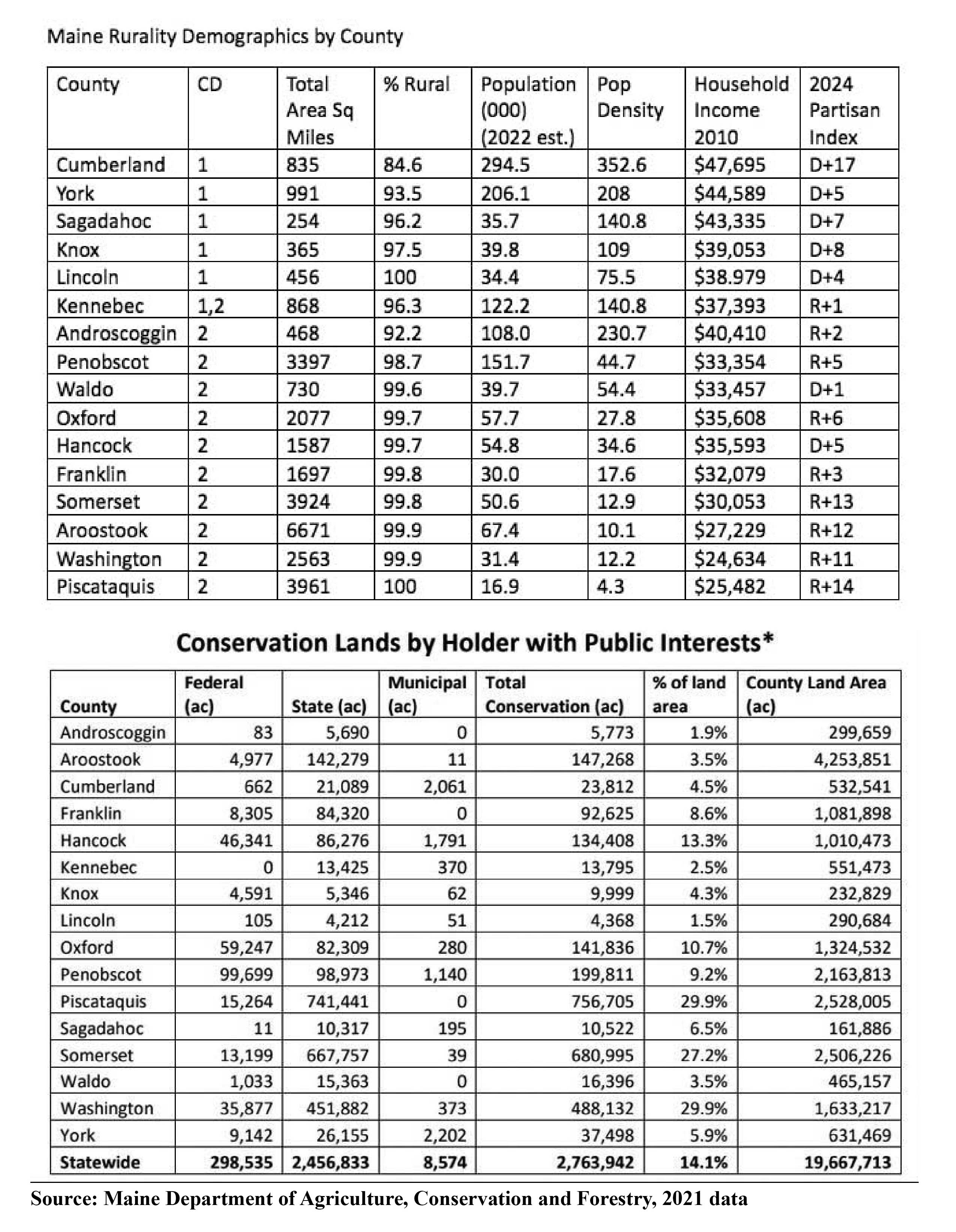Maine’s Rurality Reality: Demographics and Disparate Impact
Jon Reisman
Maine is a largely rural state, but that rurality is not distributed evenly across the State or by Congressional District (CD). Rural demographics differences include being poorer, older, more spread out (lower population density), more agrarian, and more Republican. Maine’s Congressional districts both contain significant rural/non- metro areas, but the 2nd CD is decidedly more rural, with associated demographics.
Maine is promulgating climate, energy, and equity policies that have had an adverse disparate impact on rural Maine and the 2nd CD. Climate policy has driven up energy and electricity prices, been opaque as to the size and distribution of the costs and benefits (averted climate change), and loudly pursued equity without defining it. Legislation from 2nd CD Republican leadership offered several opportunities to correct these issues. A series of party line votes assured that the adverse disparate impact will continue.
Higher energy and electricity prices have a greater negative impact on poorer and less dense rural Maine and the 2nd CD. The Climate Action Plan (https://mecpa.org/wp-content/uploads/2025/01/Maine-Climate-Action-Plan_S...) aims to increase public tax-exempt conservation lands to 30% of Maine. The vast majority of public lands holdings and likely acquisitions are in rural Maine and the 2nd CD. The Climate Action Plan (https://www.maine.gov/climateplan/sites/maine.gov.climateplan/files/2025...) also makes a major commitment to equity, but fails to define equity (https://www.maine.gov/dep/publications/documents/GOPIF%20Report%20Pursua...(LD%201682)_2-25-2022.pdf).
A series of Freedom of Access Act requests revealed that there is no definition of equity in the Maine State Government or the University of Maine System. Pursuing a policy goal without defining it is pure policy malpractice. Maine’s equity policy is to promote equity but not define it, which leaves rural Maine and the 2nd CD unable to complain about inequities which cannot be defined, identified or measured.
Rurality Reality
Data and analysis from the Census Bureau, Office of Management and Budget, and the Department of Agriculture classify Maine Counties as follows (https://ers.usda.gov/sites/default/files/_laserfiche/Charts/108698/Micro...) :
Metropolitan- York, Cumberland, Sagadahoc, Androscoggin, Penobscot
Nonmetropolitan-Micropolitan- Kennebec
Nonmetropolitan-Noncore- Lincoln, Knox, Oxford, Franklin, Somerset, Piscataquis, Aroostook, Waldo, Hancock, Washington.
The table above summarizes Maine (https://localistica.com/usa/me/counties/all-counties/) rurality demographics (https://stacker.com/stories/maine/most-rural-counties-maine).
In 2020, median household income in the more urban 1st CD was $57,200 (https://statisticalatlas.com/congressional-district/Maine/Congressional-...) and $44,600 in the more rural 2nd CD (https://statisticalatlas.com/congressional-district/Maine/Congressional-...) , almost a third higher. That difference, when combined with lower density and the partisan index, is primarily responsible for the adverse disparate impact of climate policy on rural Maine and the 2nd CD.
Climate Policy
Green House Gas (GHG) Emissions, Energy/Electricity Prices, Equity and Public Land
The Climate Action Plan sets the following goals and targets:
• Reduce Maine’s greenhouse gas emissions
• Make Maine more resilient to the impacts of climate change
• Foster economic opportunity and prosperity
• Advance equity through Maine’s response Targets 2030 – 2050
• Reduce Maine’s greenhouse gas emissions (GHG) by 45 percent below 1990 levels by 2030
• Increase the total acreage of conserved Natural and Working Lands in the state to 30 percent by 2030.
•100 percent clean energy by 2040
• Achieve State carbon neutrality by 2045
• Reduce Maine’s GHG emissions by 80 percent below 1990 levels by 2050
Policies to reduce GHG emissions include supply subsidies for solar and wind such as net energy billing and demand management efforts like Efficiency Maine. The overall effect has been to almost double electricity prices in Maine, driving them towards $.25-.30/kwh and higher. The adverse disparate impact on the older, poorer, less dense and more Republican 2nd CD is obvious.
The Climate Plan adopts broad equity goals but fails to define equity, as admitted by this FOAA response from Governor Janet Mills counsel Tim Feeley. (Oct. 9, 2025 Advertiser)
Additional FOAA requests revealed that despite broad promotion of equity, there is no definition across Maine State Government (including the Department of Environmental Protection, the Public Utilities Commission, the Attorney General and the University of Maine System) with the lone exception of this from the Department of Health and Human Services DEI plan (https://www.maine.gov/dhhs/sites/maine.gov.dhhs/files/inline-files/Strat... ) :
Equity – when barriers are identified and removed to ensure fair treatment, equality of opportunity, and fairness in access to information and resources for all.
Promoting a policy goal without defining it and developing metrics is pure policy malpractice. In addition, the failure to define equity (fairness) means that residents of rural Maine and the 2nd CD have no clear path to identify and deal with inequities and the adverse disparate impacts the climate plan creates.
Previous FOAA requests on public/conservation lands revealed that Maine has increased holdings using generous Land for Maine’s Future funding. This table and map show the 30% goal would require doubling public lands holdings by adding 3 million acres. Public lands holdings and acquisitions are concentrated in the 2nd CD- no County in the 1st CD has even double digits in public holdings: The 30% public lands goal has an adverse disparate impact on the 2nd CD, removing much larger percentages of the tax base, and it is only going to get worse.
Unabated Adverse Disparate Impact
Republican House Leader Billy Bob Faulkingham (R-Winter Harbor) sponsored several bills to address the adverse disparate impact of the climate plan:
LD 495 (https://legislature.maine.gov/bills/getPDF.asp?paper=HP0116&item=1&snum=132) -An Act to Cap Publicly Owned Land Area at No More than 50 Percent of Any County;
LD 1494 (https://legislature.maine.gov/bills/getPDF.asp?paper=HP0324&item=1&snum=132) - An Act to Require Rules Designed to Reduce Climate Change to Include Estimates of the Reduction in Adverse Climate Effects and of the Cost to Consumers;
LD 1593 (https://legislature.maine.gov/backend/App/services/getDocument.aspx?docu...)
- An Act to Require Certain Public Entities to Define Their Use of the Term “Equity.”
LD 495 was unanimously voted “ought not to pass” in committee and killed. LDs 1494 and 1593 got divided majority “ought not to pass” party-line committee and floor votes and were defeated. The adverse disparate impact will continue unabated.
Jon Reisman is an economist and policy analyst who retired from the University of Maine at Machias after 38 years. He resides on Cathance Lake in Cooper, where he is a Statler and Waldorf intern. Mr. Reisman’s views are his own, and he welcomes comments as letters to the editor here or to him directly via email at [email protected].





